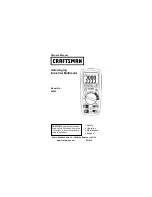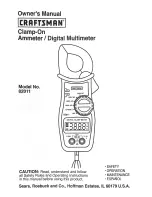
49
Note
- When measuring low resistance, the test leads can add 0.1 to 0.2 of error to resistance
measurement.
To test the leads, touch the probe tips together and read the resistance of the leads. If necessary,
you can press
REL
to automatically subtract this value.
- For high-resistance measurement (>1M ), it is normal taking several seconds to obtain a stable
reading.
In order to obtain precision readings, use the test lead as short as possible.
- The LCD displays
OL
indicating open-circuit or the tested resistor value is higher than the
maximum range of the Meter.
- When testing the resistance signal from the calibrator, it is necessary to press and hold the
RANGE
while turning on the Meter to change the maximum display to 2000 counts but the
accuracy remains unchanged.
- When resistance measurement has been completed, disconnect the connection between the
testing leads and the circuit under test and remove testing leads away from the input terminals.
D. Testing for Continuity
Warning!
To avoid harms to you, please do not attempt to input voltage higher than 60V DC
or 30V rms AC.
To avoid possible damages to the Meter or to the devices under test, disconnect
circuit power and discharge all the high-voltage capacitors before measuring
continuity.
To test for continuity, set up the Meter as Figure 3-4 and do the following:
1. Insert the red test lead into the terminal and the black test lead into the
COM
terminal.
2. Set the rotary switch to
; press
BLUE
button to select
measurement mode and
connet the test leads across with the object being tested.
3. The beeper comes on continuously for open conditions, that is test resistance ≤50
.
The
BLUE
button cycles among resistance, continuity, and diode.
Figure 3-4. Continuity Test
Note
Open circuit voltage around –1.2V and range is 400 measurement range.
When continuity testing has been completed, disconnect the connection between the testing
leads and the circuit under test and remove the test leads away from the input terminals.
















































